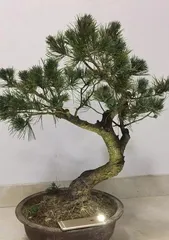Pine bonsai, with its profound cultural connotations and strong ornamental value, has always been favored by bonsai enthusiasts. To create a exquisite pine bonsai, the first step is to choose the right variety. This article will introduce the advantages and disadvantages of pine bonsai varieties from multiple aspects such as ornamental effect and growth habits, helping readers select the most suitable pine bonsai for themselves.

One: Red Pine
Red Pine is one of the more common varieties in pine bonsai. Its trunk is sturdy, the crown is tall and full of branches, presenting a rich northern style. In addition, the trunk shape of Red Pine is variable, and it can be shaped into various bonsai forms.
Two: Yunnan Pine
Yunnan Pine is a pine variety with a southern charm, favored for its flexible branches and semi-evergreen leaves. In addition, Yunnan Pine has diverse tree shapes and can be crafted into bonsai of different styles, making it particularly suitable for display bonsai.

Three: Five-needle Pine
Five-needle Pine is renowned for its unique leaf shape and purple-red cones, and is one of the highly esteemed varieties in pine bonsai. It grows relatively fast and is also cold and drought tolerant, making it suitable for large bonsai or landscape trees.
Four: Hainan Pine
Hainan Pine grows in tropical rainforests and is beloved in the bonsai world for its southern tropical charm. Its branches are soft and variable, making it suitable for display bonsai. At the same time, its delicate and exquisite shape makes it the top choice for creating mini bonsai.
Five: Green Pine
As a representative plant in traditional Chinese culture, Green Pine has been an important material in the art of bonsai since ancient times. Its branches are straight and its trunk is upright, making it suitable for three-dimensional bonsai or bonsai that intentionally expresses Taoist philosophy.

Six: Huashan Pine
Huashan Pine is a common pine variety in southern China. Its main trunk is sturdy, with dense branches, and the branches are straight and hard. The bonsai styles of Huashan Pine are diverse and can be made into mountain and rock landscape bonsai or used as background trees.
Seven: Liaodong Pine
Liaodong Pine grows in northern regions like Liaoning and is one of the more representative varieties in pine bonsai. It has a sturdy trunk, a tall crown, and an elegant tree shape, making it suitable for medium to large bonsai.
Eight: Horse-tail Pine
The crown of Horse-tail Pine is fan-shaped, and its branches are flexible and easy to prune and shape, making it a common variety for shaped and mini bonsai. In addition, the thick and glossy leaves of Horse-tail Pine also reflect its ornamental value.
Nine: Fir
Fir grows in high-altitude cold regions. Its crown is small and compact, with abundant and dense branches and leaves, and the plant itself has a special fragrance. The bonsai styles of Fir are diverse and suitable for mountain and rock landscape bonsai or small display bonsai.
Ten: East China Spruce
Also known as fragrant fir, the East China Spruce is endowed with an elegant and fresh image in the art of bonsai. Its trunk is straight, and its crown is conical or pyramidal, making it suitable for high-end bonsai or office greening.
Eleven: Stone Mountain Pine
Also known as Xiushan Pine, it grows in high-altitude mountainous areas. Its branches and leaves are lush, presenting a strong mountain and wild atmosphere, making it suitable for landscape bonsai or natural scene bonsai.
Twelve: Huangshan Pine
Huangshan Pine grows in southern China and is widely used in the art of bonsai for its soft branches and leaves and beautiful tree shape. The bonsai styles of Huangshan Pine are diverse, suitable for display bonsai or indoor bonsai.
Thirteen: Taiwan Pine
Taiwan Pine grows in subtropical regions and is beloved by bonsai enthusiasts for its flexible branches and semi-evergreen leaves. The bonsai styles of Taiwan Pine are diverse, suitable for display bonsai or mini bonsai.
Fourteen: Bald Cypress
Bald Cypress grows in North America and East Asia and is highly regarded for its sturdy trunk and lush foliage. The bonsai styles of Bald Cypress are diverse, suitable for medium to large bonsai or display bonsai.
Fifteen:
There are many varieties of pine bonsai, each with its own unique characteristics. To select the most suitable variety, one needs to consider multiple factors such as bonsai style, ornamental effect, and growth habits. Through the detailed introduction of various pine varieties in this article, it is believed that readers have gained a deeper understanding of how to choose a pine bonsai variety.